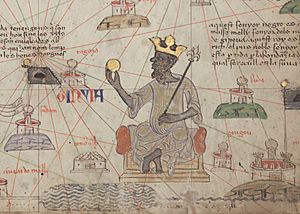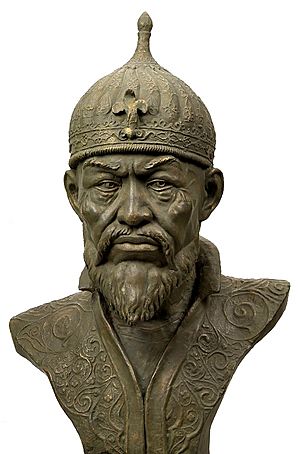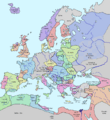14th century facts for kids
| Millennium: | 2nd millennium |
|---|---|
| Centuries: | 13th century · 14th century · 15th century |
| Decades: | 1300s 1310s 1320s 1330s 1340s 1350s 1360s 1370s 1380s 1390s |
| Categories: | Births – Deaths Establishments – Disestablishments |
The 14th century was a time period that lasted from the year 1301 to 1400. It was a century filled with big changes, challenges, and new ideas across the world. Imagine a time without modern medicine, fast travel, or the internet! People faced many difficulties, but also made amazing discoveries and created beautiful art.
This century saw major events like a terrible plague that swept across continents, long wars between kingdoms, and the rise of powerful new leaders. It was a time when different cultures connected more, leading to new ways of thinking and living.
Contents
What Was Europe Like?
Europe in the 14th century was a place of great upheaval. Kingdoms were often at war, and the lives of ordinary people were very hard.
The Black Death
One of the most important and tragic events was the arrival of the Black Death. This terrible plague spread quickly across Europe starting around 1347. It was caused by a type of bacteria and was carried by fleas on rats.
- The Black Death killed millions of people, sometimes half or even more of the population in some areas.
- It caused huge changes in society. With fewer people, workers became more valuable.
- This led to changes in how land was owned and how people were paid for their work.
Long Wars and Conflicts
Many parts of Europe were involved in long and bloody wars. These conflicts often changed the borders of countries and the power of kings.
- The Hundred Years' War was a long series of battles between England and France. It started in 1337 and lasted for over a hundred years.
- The Wars of Scottish Independence continued in Scotland, where Scottish leaders fought to keep their country free from English rule.
The Italian Renaissance Begins
Even with all the difficulties, new ideas started to bloom, especially in Italy. This period is known as the Italian Renaissance.
- The Renaissance was a time of renewed interest in art, science, and learning.
- Artists like Giotto started to paint in new, more realistic ways.
- Writers began to create famous works that are still read today.
- This movement would later spread across the rest of Europe.
What Was Asia Like?
Asia was also a place of powerful empires and significant changes during the 14th century.
The Mongol Empire's Influence
The huge Mongol Empire, which had been very powerful, started to break apart into smaller parts. However, its influence was still felt across Asia.
- Trade routes like the Silk Road continued to connect different parts of Asia, allowing goods and ideas to travel.
- New leaders emerged in regions once controlled by the Mongols.
The Rise of Tamerlane
One of the most famous conquerors of this century was Tamerlane, also known as Timur. He was a powerful military leader who built a vast empire.
- Tamerlane's empire stretched across Central Asia, Persia, and parts of India.
- He was known for his military skills and for building impressive cities.
- His conquests had a big impact on the history of many countries.
Developments in Japan
Japan experienced a time of political change and conflict.
- The Kamakura period ended, and the Muromachi period began.
- There was a period called the Nanboku-chō period, where two different imperial courts claimed to be the rightful rulers.
- This led to many battles and a lot of instability.
What Was Africa Like?
Africa was home to rich and powerful kingdoms that were important centers of trade and culture.
The Mali Empire
The Mali Empire in West Africa was one of the wealthiest and most influential empires of its time.
- It was famous for its gold and salt trade.
- Mansa Musa, one of its most famous rulers, was known for his incredible wealth.
- He made a famous pilgrimage to Mecca, showing the empire's power and the spread of Islam in the region.

Important Discoveries and Inventions
Even though life was tough, people continued to innovate.
- New types of ships were developed, making sea travel and trade easier.
- Improvements in farming tools helped people grow more food.
- The use of gunpowder in warfare became more common, changing how battles were fought.
Related pages
Images for kids
-
This 14th-century statue from Tamil Nadu, present day India depicts the gods Shiva (on the left) and Uma (on the right). It is housed in the Smithsonian Institution in Washington, D.C.
-
The Battle of Aljubarrota between the Portuguese and Castilians in 1385.
-
Tamerlane defeats the Sultan of Delhi, Nasir-ud-Din Mahmud Shah Tughluq, in the winter of 1397–1398. This painting is from 1595–1600.
See also
 In Spanish: Siglo XIV para niños
In Spanish: Siglo XIV para niños






